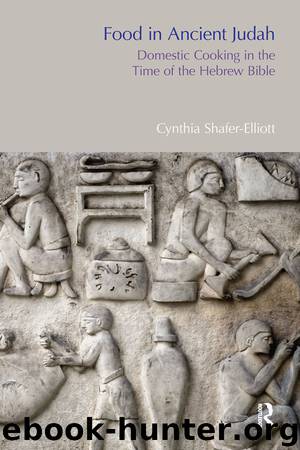Food in Ancient Judah by Shafer-Elliott Cynthia

Author:Shafer-Elliott, Cynthia
Language: eng
Format: epub
ISBN: 9781317543503
Publisher: Taylor & Francis (CAM)
Bottero’s assessment of bread-baking techniques in ancient Mesopotamia is worthy of note; however, McQuitty and van der Steen do not mention whether or not the bread was leavened. Perhaps Bottero’s understanding reflects an elite context; surely, the average Mesopotamian would not have had the luxury of two different types of bread ovens. Perhaps bread molds in Mesopotamia were baked in one type of an oven (a tabun?) over the other.20 Furthermore, Bottero’s argument does not reflect the techniques used in ancient Israel and Judah nor in present-day traditional societies, as will be shown below.
Traditional societies still exist in many parts of the world, although their numbers are dwindling due to the rapid spread of industrialism and technology. Cultural anthropologists, ethnographers, and ethnoarchae-ologists are accelerating their observations of these traditional societies in fear of their extinction. Many of these societies still employ the bread ovens described above. But, from an archaeological perspective, it only makes sense to focus on the two types found in excavations in the southern Levant: tannaneer and tawabeen.
Both tannaneer and tawabeen are still in use today, although not nearly as much as they would have been in antiquity. Bradly Parker’s study of tandir (a variation of the words tandoori and tannur) ovens in present-day southeastern Anatolia provides a glimpse into how tannur ovens could have been used in antiquity.21 Parker studied the use of tandir ovens by eleven families from four different villages and documented their consistent employment. Unleavened dough made of flour, salt, and water is shaped into small balls. The interior surface of the oven is wiped clean before each use and is heated with fuel consisting of dung and dried brush an hour or so before baking. The unleavened dough balls are flattened and brushed with egg before being stuck to the walls of the oven. Parker estimates that approximately ten to fifteen loaves can be cooked simultaneously and this is usually done in the late afternoon to avoid the heat of the day and so that the bread is hot from the oven for the evening meal.22 Parker also makes note that, in the present-day villages under consideration, the tandir ovens were “almost exclusively used to make unleavened flat bread” and argues that “this is reflected in the structure of tandir ovens which are clearly not designed for other types of cooking.” He supports this argument by citing only three instances where the tandir was used by his informants to cook something other than bread: twice eggplants were roasted and once peppers were roasted.23 As will be shown further on, other ethnoarchae-ologists disagree with this observation, but it can perhaps be used to demonstrate that oven use varied regionally.
Parker goes on to note that the majority of the tandirs were not found in individual homes. Rather, most villages had common oven houses between houses or on the street; only the wealthy possessed their own tandir at or near their homes or house compounds. The communal bread oven could be an indicator as to
Download
This site does not store any files on its server. We only index and link to content provided by other sites. Please contact the content providers to delete copyright contents if any and email us, we'll remove relevant links or contents immediately.
The Five People You Meet in Heaven by Mitch Albom(3475)
The Secret Power of Speaking God's Word by Joyce Meyer(2975)
Real Sex by Lauren F. Winner(2967)
Name Book, The: Over 10,000 Names--Their Meanings, Origins, and Spiritual Significance by Astoria Dorothy(2940)
The Holy Spirit by Billy Graham(2893)
0041152001443424520 .pdf by Unknown(2784)
ESV Study Bible by Crossway(2732)
How The Mind Works by Steven Pinker(2729)
Ancient Worlds by Michael Scott(2626)
Churchill by Paul Johnson(2506)
The Meaning of the Library by unknow(2505)
The ESV Study Bible by Crossway Bibles(2502)
The Gnostic Gospels by Pagels Elaine(2472)
MOSES THE EGYPTIAN by Jan Assmann(2373)
Jesus by Paul Johnson(2310)
City of Stairs by Robert Jackson Bennett(2309)
The Complete Dead Sea Scrolls in English (7th Edition) (Penguin Classics) by Geza Vermes(2236)
Ancient Near Eastern Thought and the Old Testament by John H. Walton(2196)
The Nativity by Geza Vermes(2180)
